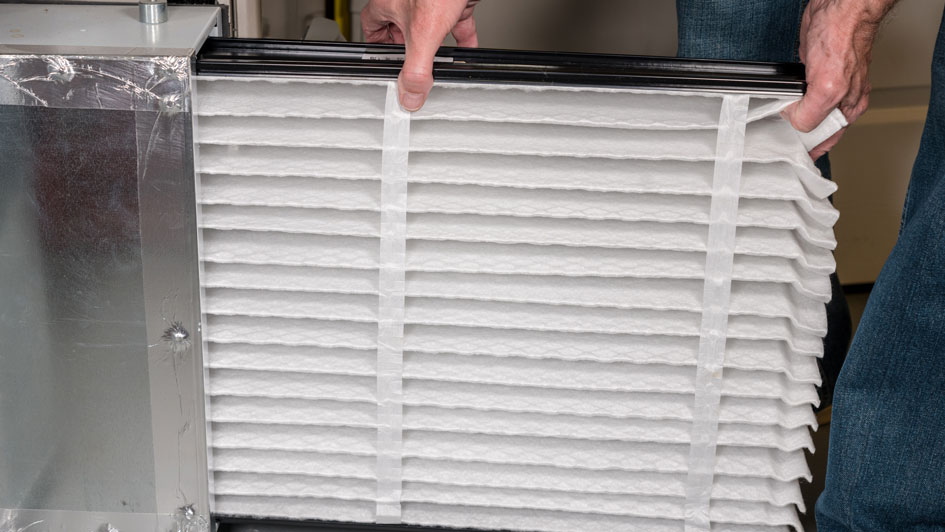
Selecting the right furnace filter and changing it when it gets dirty is as important to your HVAC system as changing the oil is to your car. Each plays a crucial part in keeping its system running safely, efficiently and for a long time.
A dirty furnace filter loses its effectiveness, enabling potentially harmful particles to flow through your home. It also limits airflow, which can damage your furnace and decrease its life span.
Ensuring your furnace uses a clean filter that is suitable for your needs is not merely about keeping your furnace running efficiently. It’s also about creating excellent indoor air quality for your residence.
Your health is important to the HVAC pros at Kapaun & Brown. We've long been dedicated to bettering indoor air quality in Marshalltown. Here, we’ve answered common questions about HVAC filters, including that very tricky question of what direction do you point a filter in your furnace or air conditioner?
How Often to Replace the Air Filter in a Furnace
It is important to replace dirty air filters in a furnace or air conditioner periodically. Dirty filters cause the system to worker harder than it should because it takes extra work to move air through the plugged-up filter.
Officials recommend examining your furnace filter every 30 days and replacing it if it’s dirty. You’ll know if your filter needs changing because it will coated with dirt or dust. Those who have pets will probably have to replace their furnace air filter more often, because an effective air filter will trap pet hair circulating in a home.
Where Is the Air Filter in My Furnace?
In general, a furnace air filter is normally located in the return air duct or blower compartment before the return air gets to the furnace. This is so air being pulled into the system is filtered before it goes through the furnace components and is heated.
Depending on the furnace brand, the filter may be located on the right, left, bottom or in some cases, on the inside of the furnace. It's typically housed in a slot, frame or cabinet for simple access and replacement. Always refer to your furnace's owner manual for facts regarding filter location of your furnace.
Is My Furnace Filter Just a Type of Air Filter?
The straightforward answer is, yes. In HVAC, a furnace filter and an air filter or air conditioning filter are essentially the same. While people may call them different things based on the current season— warm or chilly months—they are all filters that clean the air in your home.
They each eliminate dust, allergens, bacteria and other contaminants from the air that is drawn into the furnace and air conditioning system, ensuring the air circulating throughout your home is clean and safe.
What Is a MERV Rating and What MERV Rating Do I Need?
Once you locate your old furnace filter and determine when it should be changed, it’s time to pick a replacement. That means picking the level of filtration that you need. One approach to this is by picking an appropriate MERV rating for your needs.
MERV is an abbreviation for Minimum Efficiency Reporting Values. The MERV rating calculates the effectiveness of air filters at trapping airborne molecules. The rating scale ranges from 1 to 20, with bigger numbers indicating enhanced capabilities to filter smaller particles.
Experts say a filter with a MERV rating between 8 and 13 offers an appropriate balance between having adequate indoor air quality without unnecessarily restricting airflow. However, people with certain health conditions might need to use a filter with a higher MERV rating.
Where to Insert the Air Filter in a Furnace or Air Conditioning System
Installing an air filter in a furnace or air conditioner the proper way is important for the efficient operation of the unit. Air filters have a specific direction, indicated by an arrow written on the side of the filter frame. The filter should be placed in the unit with this arrow pointing in the direction of the furnace or air conditioning unit, which is the direction of the airflow. If you're not sure about the airflow direction, remember that air always moves from the return duct and then to the heat or cooling source. Therefore, make sure the arrow points in the direction of the furnace or AC.
Many people have difficulty remembering which direction to face their system's air filter. To help remember, consider taking a quick picture with your cellular phone after the filter has been properly installed by a professional. Or, you also could ask a technician to use a marker to write on the outside of your furnace which direction the filter should point. A perfect time to inquire about this is during a routine furnace maintenance call.
How to Change a Furnace Air Filter
Replacing the filter on your furnace or air conditioning system is a quick and easy process. Here is a step-by-step list of how to remove a dirty air filter and replace it with a new one:
- Turn off your furnace: Be sure to switch off your furnace before starting up the process.
- Locate the furnace filter: Typically, the filter is found within the furnace or in the air return vent. Make note of which direction the arrow points on the filter, because you’ll want the arrow on the clean filter to point similarly.
- Remove the old filter: Be diligent not to knock out any dust or particles.
- Record the date: Write down the date you replaced the filter on the new filter's frame. This will make it easier to keep track of when it's time for the next change.
- Insert new filter: Put in the new filter with the arrow pointing at the furnace, which is the direction of airflow and should be the same direction the arrow pointed on the old filter you are replacing.
- Secure the filter: Make sure the new filter fits nicely and close any latches or clips that lock it in the unit.
- Turn on your furnace: Once the clean filter is safely installed, you can turn your furnace back on.
Will a Dirty Air Filter Cause a Furnace Not to Work?
The shortest answer is, yes, a dirty air filter can cause a furnace to stop working or shorten its lifespan. Changing your furnace or air conditioning filter is one of the simplest things you can do to keep your system working efficiently.
